Past Year Questions: Railway & Airport Engineering | Transportation Engineering - Civil Engineering (CE) PDF Download
Q1: A horizontal curve of radius 1080 m (with transition curves on either side) in a Broad Gauge railway track is designed and constructed for an equilibrium speed of 70kmph. However, a few years after construction, the Railway Authorities decided to run express trains on this track. The maximum allowable cant deficiency is 10 cm. The maximum restricted speed (in kmph ) of the express trains running on this track is _____ (rounded off to the nearest integer) [2024, Set-2]
Ans: 112 to 116
Sol: Constructed equilibrium cant  With allowable cant deficiency of 100 mm
With allowable cant deficiency of 100 mm
Maximum speed of train can run with theoretical cant = 62.52 +100 = 162.52 mm
Q2: The longitudinal sections of a runway have gradients as shown in the table. [2024, Set-2]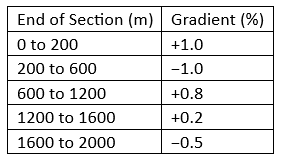
Consider the reduced level (RL) at the starting point of the runway as 100 m. The effective gradient of the runway is
(a) 0.02%
(b) 0.35%
(c) 0.28%
(d) 0.18%
Ans: (c)
Sol: 
Q3: The number of trains and their corresponding speeds for a curved Broad Gauge section with 437 m radius are [2024, Set-1]
20 trains at a speed of 40 kmph
15 trains at a speed of 50 kmph
12 trains at a speed of 60 kmph
8 trains at a speed of 70 kmph
3 trains at a speed of 80 kmph
If the gauge (center to center distance between the rail heads) is taken as
1750 mm, the required equilibrium cant (in mm ) will be ____ (rounded off to the nearest integer)
Ans: 86 to 90
Sol: 
Q4: As per the International Civil Aviation Organization (ICAO), the basic runway length is increased b × (%) for every y (m) raise in elevation from the Mean Sea Level (MSL) The values of x and y respectively, are [2024, Set-1]
(a) 7% and 300 m
(b) 5% and 200m
(c) 4% and 500m
(d)10% and 1000m
Ans: (a)
Sol: As per ICAO, basic runway length must be increased by 7% for 300 m elevation from MSL.
Q1: For a 2∘ curve on a high speed Broad Gauge (BG) rail section, the maximum sanctioned speed is 100 km/h and the equilibrium speed is 80 km/h. Consider dynamic gauge of BG rail as 1750 mm. The degree of curve is defined as the angle subtended at its center by a 30.5 m arc. The cant deficiency for the curve (in mm, round off to integer) is ________________ [2021, Set-2]
Ans: 55 to 59
Sol: Length of curve = Radius x Degree of curve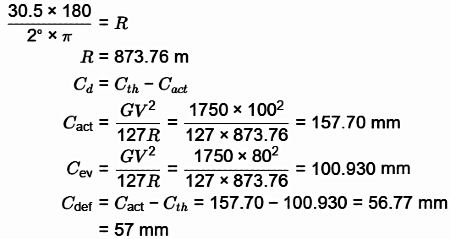
Q2: The longitudinal section of a runway provides the following data: [2021, Set-1]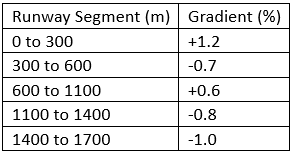
Ans: 0.3 to 0.34
Sol: Assuming RL of start of runway as datum i.e., RL = 0 m)

Q1: For the hottest month of the year at the proposed airport site, the monthly mean of the average daily temperature is 39∘C. The monthly mean of the maximum daily temperature is 48∘C for the same month of the year. From the given information, the calculated Airport Reference Temperature (in ∘C ), is [2020, Set-2]
(a) 36
(b) 39
(c) 42
(d) 48
Ans: (c)
Sol: Ta = 39∘C
Tm = 48∘C
Q2: The appropriate design length of a clearway is calculated on the basis of 'Normal Takeoff' condition. Which one of the following options correctly depicts the length of the clearway? [2020, Set-1]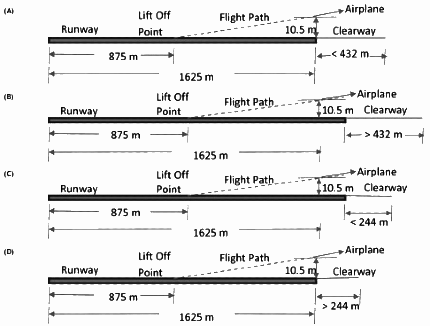 (a) A
(a) A
(b) B
(c) C
(d) D
Ans: (a)
Sol:
For normal take off condition:
Clearway ≯ 1/2 (1.5 of take off distance
−1.15of lift off distance)
≯ 1/2 (1.15 x 1625 - 1.15 x 875)
≯ 431.25m
So clearway is less then for 432 m.
Q 1. A broad gauge railway line passes through a horizontal curved section (radius = 875 m) of length 200 m. The allowable speed on this portion is 100 km/h. For calculating the cant, consider the gauge as center -to -center distance between the rail heads, equal to 1750 mm. The maximum permissible cant (in mm, round off to 1 decimal place) with respect to the center-to-center distance between the rail heads is_______ [2019, Set-2]
Ans: 157.2 to 157.6
Sol: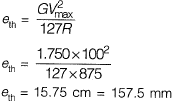
Question 2. For a broad gauge railway track on a horizontal curve of radius R (in m), the equilibrium cant e required for a train moving at a speed of V(in km per hour) is [2017 : 1 Mark, Set-II]
(a) 
(b) 
(c) 
(d) 
Answer: (b)
Solution: 
Question 3. A runway is being constructed in a new airport as per the International Civil Aviation Organization (ICAO) recommendations. The elevation and the airport reference temperature of this airport are 535 m above the mean sea level and 22.65°C, respectively. Consider the effective gradient of runway as 1%. The length of runway required for a design-aircraft under the standard conditions is 2000 m. Within the framework of applying sequential corrections as per the ICAO recommendations, the length of runway corrected for the temperature is [2017 : 1 Mark, Set-I]
(a) 2223 m
(b) 2250 m
(c) 2500 m
(d) 2750 m
Answer: (c)
Solution: Elevation = 535 m
Airport Reference Temperature = 22.65° C
Effective Gradient = 1%
Runway length = 2000 m under standard conditions.
Runway length correction for T°C.
=> Correction for elevation
Corrected runway length = 2249.67 m
=> Corrected standard T° at 535 m elevation
= 15°C - (0.0065 x 535) = 11.52°C
Correction for T°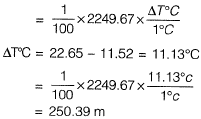
Corrected Runway length
= 2249.67 + 250.39
Combined elevation and temperature correction
= 500 m < (0.35 x 2000)
|
26 videos|102 docs|58 tests
|
FAQs on Past Year Questions: Railway & Airport Engineering - Transportation Engineering - Civil Engineering (CE)
| 1. What is the purpose of railway engineering? |  |
| 2. What are the key factors considered in airport engineering? |  |
| 3. How are railway tracks designed? |  |
| 4. What are the challenges in airport engineering? |  |
| 5. What are the different types of airports? |  |
















